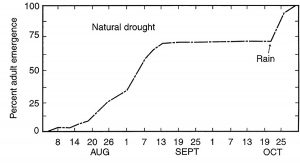Effective Pecan Weevil Management is Multi-Step Process

In the graphs that accompany this article, one shows the normal emergence pattern of adult pecan weevils when emergence is not impeded by drought-hardened soils and the other shows emergence under drought conditions, which is referred to as drought-delayed emergence.
Research has shown that the pecan weevil adults typically emerge from their soil cells from mid-August to mid-September with approximately 80 percent of emergence occurring from Aug. 20 to Sept. 10, under a normal emergence.
The focus of a pecan weevil management program is very simple – prevent females from ovipositing in developing kernels… period. But, in order to do this, producers must understand when pecans are susceptible to egg lay. Nuts still in the water stage are not susceptible to oviposition and damage from feeding is very light, (around 0.2 nuts per weevil per day according to research) so treatments can be delayed. However, as kernel development progresses from the gel stage to dough, which first occurs at the tip end of the nut, the pecan is now susceptible.
Pecan varieties like ‘Pawnee’ begin kernel formation in early August and should be protected based on the stage of kernel formation, regardless of the presence of adults in emergence traps. Treatment of later maturing varieties that are still in the water stage could be delayed, depending on how varieties are laid out.
A pecan weevil insecticide program will require at least two treatments, sometimes three if there is a prolonged emergence. The first application is when the kernels of the earliest maturing varieties start dough formation, with the second application 10 days after the first, if adults are being collected in traps. If adults are not being collected then the second treatment can be delayed until trap catches start. Adult emergence traps should be monitored until the latest maturing variety has reached shuck split.
Carbaryl has been the recommended active ingredient for many years but other recommended active ingredients found in the Texas A&M commercial pecan guide include: bifenthrin, lambda-cyhalothrin, zeta-cypermethrin and zeta-cypermethrin+bifenthrin.
One potential problem that can lead to a drought-delayed emergence and unexpected damage is with heavy clay soils under drip, micro-sprinkler, soaker hose, or other form of irrigation that does not uniformly wet the area under the drip-line. The wetted soils may be quite soft, but adjacent areas under the same tree may remain quite hard and lead to a delayed emergence.
In summary, a pecan weevil management program includes: monitoring kernel development of the earliest maturing varieties to know when oviposition may start; use of adult emergence traps to detect any late drought-delayed emergence; use of a recommended insecticide; and record-keeping of all activities and events that relate to pecan weevil so a pecan weevil management program can be evaluated.


